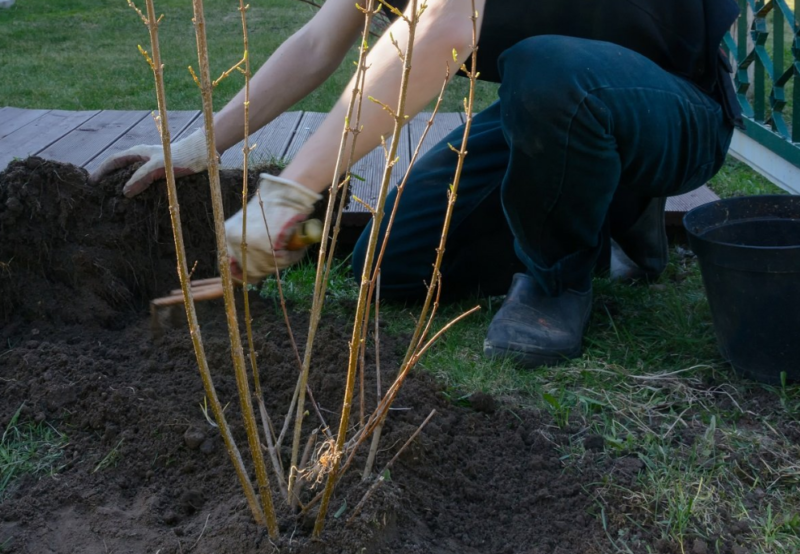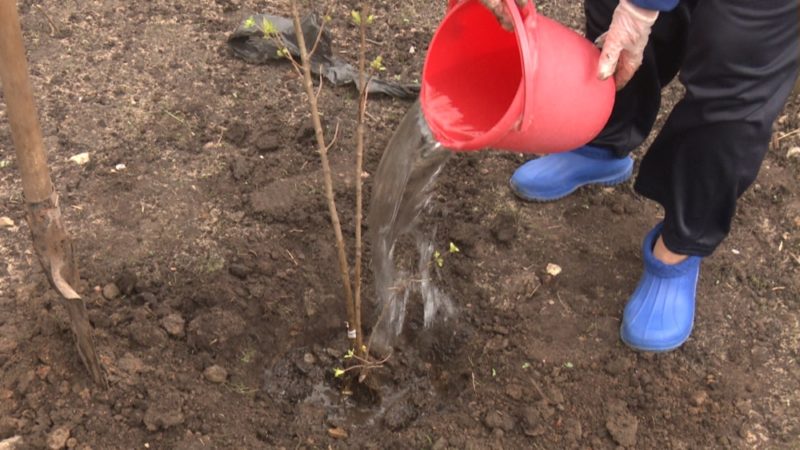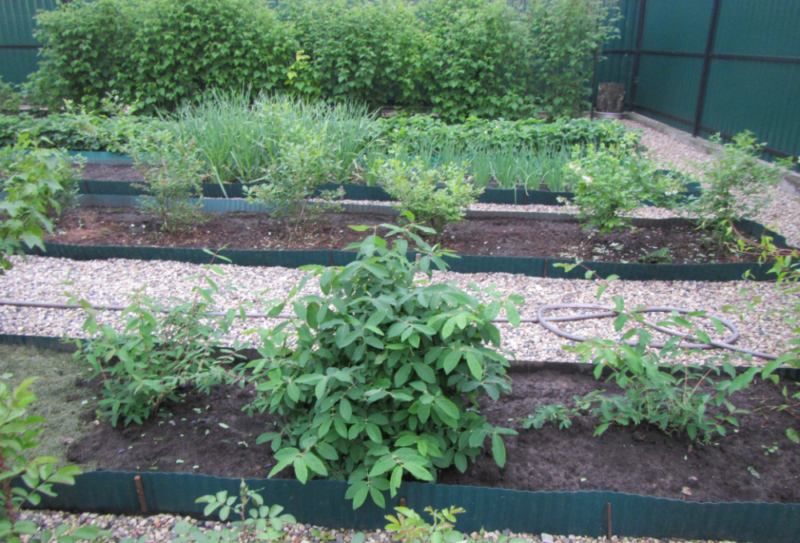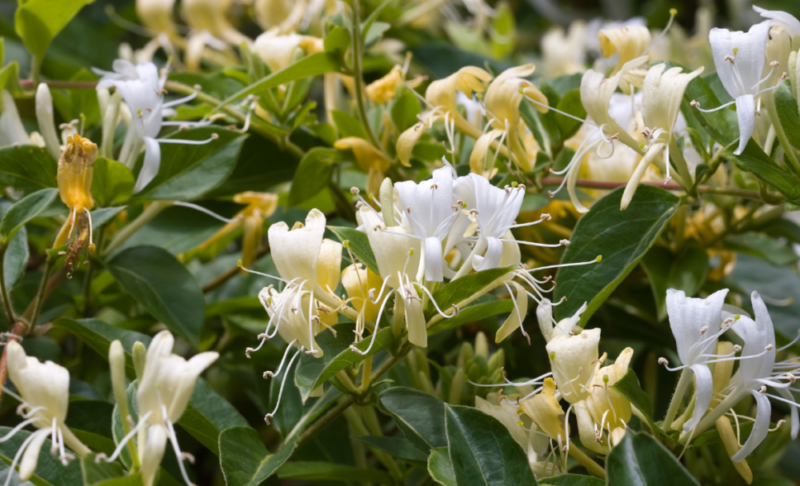Honeysuckle "Yugana" until recently was not of value to gardeners due to low taste. However, today this plant is cultivated and grown in various climatic conditions.
Material Content:
Description of a variety of honeysuckle "Yugana"
If you make a brief description of the variety, then it is a berry shrub with powerful branches. The crown is compact, not requiring trimming. The berries are dark purple with a characteristic waxy coating. In length, one fruit reaches 4 cm, weighs up to 2 g. With proper care, one plant gives up to 6 kg of delicious berries.
Berries of "Yugana" are sweetish, with a pleasant acidity, a little tart. The fruits are harvested only by hand several times, since the ripening of the culture is uneven. You can just shake off the ripened berries. The variety is suitable for canning, freezing, for the preparation of compotes and fresh consumption.
Outdoor landing
Honeysuckle planting begins with the selection of a suitable location. Yugana prefers open areas in the sun. Honeysuckle will grow well in light partial shade, but in this case a large harvest is not worth the wait.
Before planting, holes with a width and depth of about 50 cm are marked out in a couple of weeks. Drainage is arranged at the bottom, and a 1/3 hole is poured into the hole with a mixture of humus and peat with the addition of mineral compounds in which nitrogen should predominate.
When planting, it is important to ensure that the neck of the seedling remains 4 cm above the ground. The planted bush is shed, tamped and necessarily mulched. After planting, the plants are still not able to compete with weeds for nutrition and moisture, so in the first season they need careful care.
Plant care
Edible honeysuckle varieties "Yugana" is very unpretentious and does not require frequent watering. When the soil dries to a depth of about 20 cm, the bushes are watered, spending about 2 buckets under each. If it is rainy in the summer, then you do not need to irrigate the plants at all.
During the season, they are fed two to three times, introducing organic or complex fertilizers, which must necessarily include potassium and phosphorus. In the spring, before the awakening of the kidneys, nitrate or urea is introduced. In the summer, they are fed a weak solution of fermented manure. It is important not to miss the autumn top dressing so that the honeysuckle tolerates the winter well. Culture loves ash, which can be sprayed around the bushes throughout the growing season.
To facilitate the care of shrubs, many gardeners mulch them. This can be done with coniferous litter or chopped straw. Mulch will inhibit moisture evaporation and weed growth. Under a layer of mulching material, the roots will not dry out so much under the midday sun.
Regularly planting should weed and loosen the soil. Loosening the soil is deeply impossible, since the honeysuckle has a superficial root system. It is most convenient to carry out these procedures the day after watering, while the earth is damp.
After weeding and loosening, the peritoneal circles must be mulched.
Pollination and pruning technology
Kamchatka honeysuckle needs pollinators. This helps set fruit and increase yields. Therefore, other varieties are planted in the immediate vicinity.
Best of all, "Yugans" are suitable:
- "Strezhevchanka";
- "Bakcharsky Giant";
- "Delight".
It is advisable to plant honeysuckle not in rows, like raspberries, but in small curtains. So you can attract more insects that will pollinate the flowers. The best insect pollinators are bumblebees.
Honeysuckle "Yugan" before reaching the age of fifteen, it is not necessary to trim.
Only broken shoots are removed during sanitary pruning, as well as branches that grow inside the bush.
Later, honeysuckles begin to produce very poorly. At this time, shrubs are cut 20 cm from the soil surface. So you can extend the fruiting period of the plant for another 10 years.
Winter preparations
Edible honeysuckle does not need any special shelter from the frost.
The variety is winter tolerant and can survive even severe frosts.
Therefore, it is quite enough to sprinkle young bushes with a layer of mulch, for example, fallen leaves.
Adult bushes are tied so that strong winds do not break the branches. If the winter is snowy, additionally the plants are covered with snow.
Protection against diseases and pests
Although honeysuckle is a sustainable culture against disease, the gardener may still encounter some problems.
A very common disease in berry crops is the mosaic virus. When a mosaic appears on the leaves, specks form, they become wrinkled, turn yellow. Leaves grow underdeveloped, shrubs become smaller. The virus spreads by nematodes, and can also get to the site with infected plants.
Plants strongly affected by the virus will have to be destroyed by digging with the root. If the disease managed to spread only on individual branches, they are cut to healthy tissue.
Against parasitic insects that can affect honeysuckle, garden-friendly but effective remedies should be used.
Most often, small harmful insects, spider mites, annoy the honeysuckle landings. The pest eats the sap of plants, has a body only up to 0.4 mm long. In one summer season, the pest can give up to 10 generations. In most cases, ticks enter the area along with new plants. Against the phytophage, the preparations Fitoverm, Fufanon, Actellik or Lightning are used.
A small, sucking pest that can attack edible honeysuckle is aphid honeysuckle. Insects settle on young leaves in whole colonies.Damaged leaves of the plant dry out.
The tops on which aphids settled should be cut and burned. The bushes should be sprayed immediately after flowering with Iskra or Fufanon. If there are a lot of aphids, shrubs are sprayed even after harvesting the fruits.
This dessert variety of honeysuckle is very unpretentious, so even a beginner gardener can cope with its cultivation. To avoid problems, you can not violate agricultural technology and you must follow all the rules for caring for the plant.

















